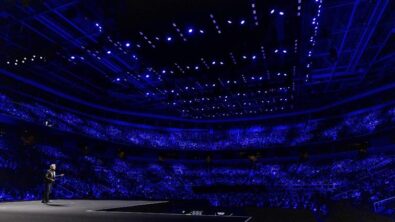Corporate
EcoCAR 2 In The News
There have been some interesting stories the past few weeks from EcoCAR2 land that reinforce why students should get involved in these hybrid projects. And why companies are investing in real-wo...
There have been some interesting stories the past few weeks from EcoCAR2 land that reinforce why students should get involved in these hybrid projects. And why companies are investing in real-world design projects like EcoCAR.
In case you missed it, the EcoCAR 2 teams announced their vehicle architectures. The press release notes:
“… each EcoCAR team designed its own unique Plug-In Hybrid Electric Vehicle (PHEV) architecture and utilized a crowd-sourcing format to select the powertrain components that it will integrate into its advanced technology vehicle over the three-year program.”
It’s great to see future engineers experiencing crowd-sourcing on real-world projects.
I also liked reading Brian Benoy’s blog post – EcoCAR 2 at the Forefront of Electrical and Computer Engineering Innovation. He is an EcoCAR alum and notes that:
“a significant gap has developed between the role that electrical and computer engineering has in the automotive industry and the number of these students that even know there is work for them out in the field.”
He educates readers on the depth of experience in electrical and computer engineering that come out of work on hybrid electric vehicles.
“Electrical and computer engineering (ECE) topics can be used everywhere from embedded component control systems to high power electrical system design in the automotive industry.”
Brian’s also embedded this video in his post.
That quote from Kent Helfrich, executive director of Electronic Controls and Software at GM, is compelling:
“The EcoCAR challenge is a way to turbocharge your education. You need to do a program like this. When people like me are looking for folks like you to hire, this is a discriminator. This is going to put your name at the top of the list.”
I like that term “discriminator.”
Another article I saw on the VirginiaTech Hybrid Electric Vehicle Team Facebook page features VT student Eli White and his work on the EcoCAR 2. The article by John Barnhart of the Bedford Bulletin quotes Eli:
“It’s definitely the most complex problem I have ever worked on.”
John gives a good overview of what a team focuses on each year of the program, starting initially with design work, then modifying the 2013 Malibu, then replacing the stock engine with an 85 percent ethanol engine. The last year is spent refining the design before final testing. He points out:
“the goal is a car that uses less energy and emits less greenhouse gasses while still maintaining the performance of the original car. The car must also be able to travel at least 200 miles on one 10-gallon tank of fuel and one charge on the battery. But that’s the minimum. The school that wins will build the car that goes the farthest beyond that minimum.”
John ends with:
“what it means for General Motors is that there will be engineers coming out of the participating universities with experience in working with hybrid cars.”
Do you think these projects are the future in engineering education? What will the classroom of the future look like?
– Dora
P.S. In case you missed it, see my earlier post on Rose-Hulman’s EcoCAR2 team lead and future engineer Jon Nibert.


